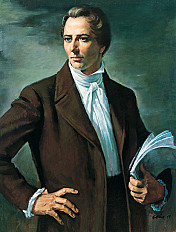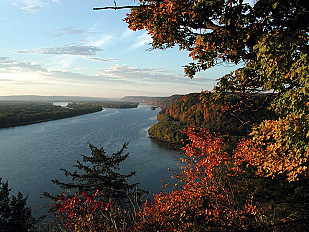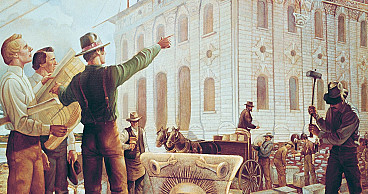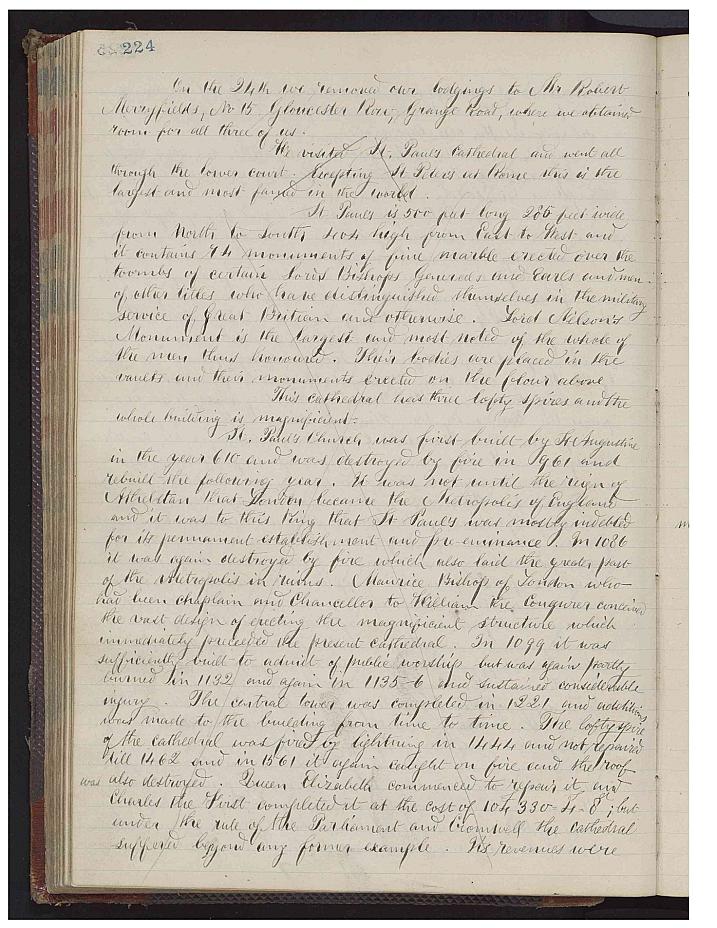
Day in the Life
Journal Entry
24th We removed our logings whare we obtained a
room for all three of us at Mr Robert Merryfield
No 15 Gloster row, Grange Rowad
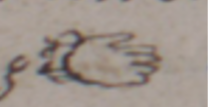 I wrote a letter to Elders Young & Richards
I wrote a letter to Elders Young & Richards
we visited St Pauls Cathedral & went all throug
the lower court & could see the splender of most of
it. It is the largest & most splended & expensive church
in the world at the present time excepting the Vatican ^church^
at Rome dedicated St Peter. It is 500 feet long from E to W.
& 285 wide from N to S. & 404 fet. high
& it contains 47 monuments of fine marble erected
over the tombs of certain Lords, Bishops, Generals, Earls
& other Titles who have distinguish themselves in the
military service of Great Britiain & otherwise Lord
Nelsons Monument is the largest & most noted, their
Bodies are placed in vaults under the building & their
monuments mostly erected on the floor above. This
cathedral bears up three lofty spires & the whole
Building is splended inside & out. It was first built
by St Augustine in the year 610. It was destroyed
by fire in 961 & rebuilt the following year. It was
not till the reign of Athelstan that London became
the metropolis of England & it was to this prince more
perhaps than to any of his predecessors that the cath
edral of St Paul was indebted for its permanant esta-
blishment & preeminance. In 1086 this cathedral was
again destroyed by fire which also involved the greater
part of the Metropolis in ruin. Maurice who was then
Bishop of London had been chaplain & chancellor to
King William conceived (says Stow) the vast design
of erecting the magnificent structure which immediately
preceded the present cathedral which was sufficiently
erected by 1099 to admit of public worship. But It was
againe partly Burned in 1132 & again in 1135–6 it sus-
tained considerably injury, the central tower was comple
ted in 1221, & they continued to add unto it from time
to time. The lofty spire of the catheeddral was fired
by lightning in 1444, & not repaired till 1462, in June
1561 the spire was again set on fire which destroyed
spire & roof, & Queen Elizabeth commenced to repair
it which was afterwards accomplished by Laud &
King Charles the first who expended £104,330. 4s. 8 p.
but Immediately dissentions arose between the king &
parliment, & the whole cathedral suffered beyound any
former example. the revenues of the church was confisc
ated, the money & materials siezed by the parliment
& the whole dody of the buidding was converted into
stables & Barracks for draggoons &c But It was
again repaired [during] the reign of Charles the second but It was
not finished before it became a pray to the flames in the
great fire of London in 1666 which desolated the
chief part of the Metropolis the above is a brief history
of St Pauls Church untill 1666,
The now present building or new cathedral was
built under the direction of Sir Christopher Wren
the first stone was laid on the 21st of June 1675 &
the highest stone of the pile was laid at the top of the
lantern by Mr Christopher Wren the son of the Architect
in the year 1710 & the last finishing & adorning the
church was Issued in 1715 by George the first
the whole expens of erecting this magnificent structure
was about £736000 ^£1,576,076 15.s^ or $3,680,000 ^$5,880,380^
entire dimentions, Length of the church from east to west
is 500. the breadth of the body of the church is 285 feet
the hight from the pavement in the street to the top of the
cross over the Dome is 404 feet. Two campanile
towers at the west end are each 222 in highth the
general highth of the wall is about 90 feet. It was
40 years in building commenced 1675 ended 1715
It covers over two (English) acres of ground)
I again visited this cathedral on the 7th of Sept &
I visited evry part of it from the lower floor to
to the Ball I walked all through the whispering
gallery a person can hear a whisper from any part of
it & when the door shuts together it penetrate
the ear like peels of thunder I next visi[t]ed the
[several lines blank]
I purchased a pamphlet giving a full history of the whole concern
People
Browse people Wilford Woodruff mentioned on this day in his journal. Click on the person's name to view a short bio and other pages they are mentioned on or click on "View in Family Search" to view their FamilySearch profile.
Places
Browse places mentioned in Wilford Woodruff's journal entry on this day. Click on the place names to view other pages where they are mentioned.
Related Documents
Browse other documents with this same date. These could include pages from Wilford Woodruff's autobiographies, daybooks, letters, histories, and personal papers. Click on the document titles to view the full document.


Events
View selected events in the two months surrounding this date in Wilford Woodruff's life. Click on the dates to jump to that day in Wilford Woodruff's journal.

